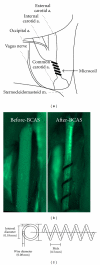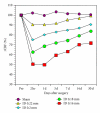Lessons from a mouse model characterizing features of vascular cognitive impairment with white matter changes
- PMID: 22132331
- PMCID: PMC3216359
- DOI: 10.4061/2011/978761
Lessons from a mouse model characterizing features of vascular cognitive impairment with white matter changes
Abstract
With the demographic shift in age in advanced countries inexorably set to progress in the 21st century, dementia will become one of the most important health problems worldwide. Vascular cognitive impairment is the second most common type of dementia after Alzheimer's disease and is frequently responsible for the cognitive decline of the elderly. It is characterized by cerebrovascular white matter changes; thus, in order to investigate the underlying mechanisms involved in white matter changes, a mouse model of chronic cerebral hypoperfusion has been developed, which involves the narrowing of the bilateral common carotid arteries with newly designed microcoils. The purpose of this paper is to provide a comprehensive summary of the achievements made with the model that shows good reproducibility of the white matter changes characterized by blood-brain barrier disruption, glial activation, oxidative stress, and oligodendrocyte loss following chronic cerebral hypoperfusion. Detailed characterization of this model may help to decipher the substrates associated with impaired memory and move toward a more integrated therapy of vascular cognitive impairment.
Figures




References
-
- Román GC, Erkinjuntti T, Wallin A, Pantoni L, Chui HC. Subcortical ischaemic vascular dementia. Lancet Neurology. 2002;1(7):426–436. - PubMed
-
- Ihara M, Tomimoto H, Ishizu K, et al. Decrease in cortical benzodiazepine receptors in symptomatic patients with leukoaraiosis: a positron emission tomography study. Stroke. 2004;35(4):942–947. - PubMed
-
- Jellinger KA. The enigma of vascular cognitive disorder and vascular dementia. Acta Neuropathologica. 2007;113(4):349–388. - PubMed
-
- Pantoni L, Garcia JH. The significance of cerebral white matter abnormalities 100 years after Binswanger’s report: a review. Stroke. 1995;26(7):1293–1301. - PubMed
-
- Meguro K, Hatazawa J, Yamaguchi T, et al. Cerebral circulation and oxygen metabolism associated with subclinical periventricular hyperintensity as shown by magnetic resonance imaging. Annals of Neurology. 1990;28(3):378–383. - PubMed
LinkOut - more resources
Full Text Sources
Other Literature Sources

